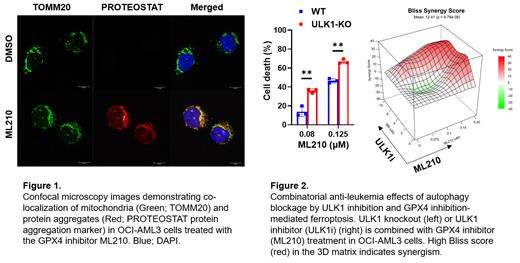Background:Resistance to apoptosis poses a major clinical challenge in the therapy of acute myeloid leukemia (AML), leading to dismal clinical outcomes. Ferroptosis, another mode of regulated cell death that could bypass apoptosis resistance, has recently been investigaed for its therapeutic potential in therapy-resistant cancers. Meanwhile, accumulating evidence suggests that the regulation of ferroptosis is highly context-dependent and thus varies among cancer types. Hence, it is crucial to elucidate unique regulatory mechanisms in each tumor type for developing a therapeutic strategy. We recently found cell survival dependence of AML cells on GPX4, a major negative regulator of ferroptosis, and unique mechanistic involvement of mitochondria in AML ferroptosis.
Results: We demonstrate that a selective GPX4 inhibitor ML210 as well as GPX4 knockdown induces ferroptosis, defined by iron- and lipid-peroxidation-dependence, in AML cell lines and primary AML samples, regardless of venetoclax resistance or genetic features including TP53 mutations. The cell sensitivity was negatively correlated with GPX4 protein expressions (i.e., the lower the expression, the higher the sensitivity). Normal bone marrow cells exhibited higher GPX4 levels compared to AML cells and showed significantly less sensitivity to ML210 treatment, suggesting a potential therapeutic window for GPX4 inhibition. Anti-leukemia effects of GPX4 knockdown were also observed in vivo, leading to survival prolongation in AML xenografted mice.
Importantly, ferroptosis induction in AML cells is accompanied with and highly dependent on mitochondrial lipid peroxidation. 4-Hydroxynonenal (4-HNE) is one of the most biologically active products of lipid peroxidation, which is known to form adducts with certain amino acid residues of proteins to induce protein aggregates in the cytosol. We thus hypothesized that mitochondrial lipid peroxides induce mitochondrial protein aggregation in AML cell ferroptosis. Intriguingly, confocal microscopy revealed mitochondrial protein aggregation as evidenced by the co-localization of TOMM20 and protein aggregates detected by the PROTEOSTAT assay (Figure 1). Given that mitochondrial stress induced by protein aggregation reportedly induces mitophagy as a cellular stress response, we presumed that AML cells under the stress of ferroptosis may also show increased mitophagy. Indeed, GPX4 inhibition induced mitophagy, particularly in persistent AML cells, which was detected by the Mitophagy dye as mitochondrial acidification when fused with lysosomes, suggesting that mitophagy is a cell-protective response against ferroptosis as a quality control mechanism of malfunctioning mitochondria with lipid peroxidation and protein aggregation. Indeed, among persistent AML cells exposed to GPX4 inhibition, cells with more mitophagy were more resistant to further treatment with ML210 compared to those with less mitophagy. Consistently, an analogue of the ceramide-mediated mitophagy inducer LCL-461 (Dany, et al. 2016 Blood) suppressed GPX4 inhibition-induced ferroptosis in AML cells. On the other hand, inhibition of ULK1-dependent mitophagy through ULK1 knockout or the ULK1 inhibitor SBI0206965 (Bhattacharya, et al. 2021 Molecular Cancer Research) synergistically enhanced the anti-leukemia effects of GPX4 inhibition (Figure 2), suggesting a more effective therapeutic potential in ferroptosis in AML.
Conclusion:Our study revealed that ferroptosis in AML cells causes mitochondrial protein aggregation and that mitophagy is induced in ferroptosis-persistent AML cells as a cell-protective mechanism against ferroptosis. This provides novel mechanistic insights into mitochondrial ferroptosis in AML, suggesting the therapeutic potential of co-targeting mitophagy in ferroptosis-based therapy. Further studies are in progress to elucidate the molecular mechanisms involved as well as the in vivo efficacy and safety of the combinatorial treatment.
Disclosures
Carter:Syndax: Research Funding; PinotBio: Research Funding; PMV: Research Funding; Revolution Medicines: Research Funding. Borthakur:Astex Pharmaceuticals, Ryvu, PTC Therapeutics: Research Funding; Catamaran Bio, Abbvie, PPD Development, Protagonist Therapeutics, Janssen: Consultancy; Pacylex, Novartis, Cytomx, Bio Ascend:: Membership on an entity's Board of Directors or advisory committees. Schimmer:Jazz: Consultancy, Honoraria; Novartis: Consultancy, Honoraria; Medivir AB: Research Funding; Otsuka Pharmaceuticals: Consultancy, Honoraria; UHN: Patents & Royalties: the use of DNT cells to treat AML; Medical and Scientific Advisory Board of the Leukemia and Lymphoma Society of Canada: Membership on an entity's Board of Directors or advisory committees; Takeda Pharmaceuticals: Consultancy, Honoraria, Research Funding; BMS: Research Funding. Andreeff:PMV: Research Funding; Kintor Pharmaceutical: Research Funding.


